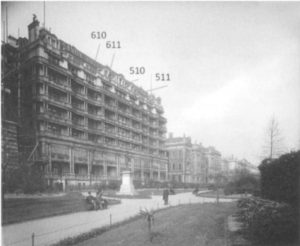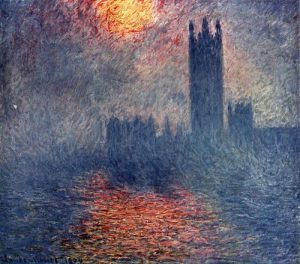Monet’s Pied-à-terre
Posted in 19th Century, 20th Century, galleries, hotels, people, Strandlines and tagged with art, Fairmont Hotel, History, Hotel, impressionism, impressionist, Layers of London, London, London history, Monet, National Gallery, painting, Savoy, Savoy Hotel, solar geometry, Visit London, Waterloo Bridge, Westminster

“I find London lovelier to paint each day”
– Claude Monet.
Monet’s link to London
Monet fell in love with London in 1870-71, while in exile from France, during the Franco-Prussian war. After his return to France he vowed to revisit London, which he did in 1899, 1900 and 1901. In each of these three later visits, he stayed in the Savoy Hotel.
The Fairmont Hotel Group proudly boasts about these visits on their blog:
“Artist Claude Monet first came to The Savoy in 1899. He returned twice more in 1900 and 1901, staying each time for about two months, and working on his famous series of views of The Thames looking up- and down-stream.” (via blog post)
From his rooms, Monet painted his now renowned depictions of Waterloo bridge and Charing Cross bridge. He also made use of his time in London to draw the Houses of Parliament from the roof of the nearby St Thomas’ Hospital. You can find out more about this period of Monet’s life and his London paintings on the National Gallery’s YouTube channel. The Gallery ran an exhibition on the painter’s London collection from April 9th to July 29th 2018.
A few examples of this work
Monet has a large portfolio of amazing art, and his London canvases are often overlooked in favour of his beautiful pastoral images. This does not mean, however, that they are not striking. The first two of the images below were painted from his Savoy window, and the third from St Thomas’s.

Left: Waterloo bridge (1903), by Claude Monet (via Claude-Monet.com)

Right: Charing Cross bridge (1899-1901), by Claude Monet (Via St Louis Art Museum)
Left: Houses of Parliament (1904), by Claude Monet (Via Claude-Monet.com)
Does the Savoy’s claim hold water?
This might seem like an odd question, as it seems fairly evident that Monet did indeed stay at the Savoy. However, there are other claims on the Fairmont Hotel Group blog that I have found to be a little erroneous. Moreover, scientists from the University of Birmingham published a paper in 2010 which poked holes in the Savoy’s narrative vis-a-vis Monet’s stay.
Solar geometry and the truth behind Monet’s stay:

The Savoy Hotel and rooms occupied by Monet in 1899 (6th floor) and in 1900 and 1901 (5th floor)
A paper titled ‘Monet at the Savoy‘ by Soraya Khan and her colleagues was published in June 2010. The team of scientists used solar geometry to reconsider the locations from which Monet painted his work.
Solar geometry, to be put simply, uses the positioning of the sun as well as landmarks in a given painting to determine positioning and timing of the painter. In the case of Monet it was used to determine which balcony or window in the Savoy he had painted from. The positioning of Cleopatra’s needle “in the foreground of two of his representations of Charing Cross Bridge”, allowed scientists to theorise where precisely Monet stayed in the Savoy.
They concluded that he used rooms 610-611 in 1899, and 510-511 in 1900/1901, contradicting the Savoy’s claims, as “rooms 512 and 513 [are marketed] as the ‘Monet Suite'”. The Telegraph was quick to point out that this was an expensive error, as the suite cost £720 per person!
Since the article was published, the Savoy has been refurbished and the Monet Suite is now positioned in the correct rooms. Susan Scott, archivist for the Savoy, clarifies this correction in a 2018 National Gallery video. In the video she explains: “these rooms are important because they’re the exact rooms that Monet painted from”. So, in this case, the Savoy’s blog claim is – now – very much accurate.
The last point to make is that the Savoy notably no longer has balconies on the river-side. It is important to point out because the National Gallery Video describes how Monet painted from his Savoy balcony. The photo above shows what the Savoy would have looked like when Monet was staying there. Per the Solar Geometry article, “the balconies were removed to make way for bathroms and the rooms were extended to the front edge of the balconies a decade later”. So, today, the closest one can get to viewing London from Monet’s perspective is to look out from the windows of rooms 610-11 and 510-11.
Final thoughts
I never thought of myself of much of an art-lover, and yet, the Monet London collection reminds the viewer of London’s eternality. The Waterloo bridge is still recognisable, despite the steamboats and pollution. I walked on it within the last couple weeks, and yet it was the inspiration for Monet’s art over a century ago! Researching for Strandlines has given me the chance to find out more about the deep connection that modern London has with its past. The Strand is an important backbone to the city. Walking down it, one is on a timeline of our city. The Savoy is one of the bastions of Strand history, and Monet’s choice to live in and paint from its rooms only highlights that even more clearly.


[…] Before structural issues led to a redesign (resulting in Giles Gilbert Scott’s concrete bridge built in 1942), Waterloo Bridge was considered the most beautiful of all London’s bridges, whose aura was captured more than once by artists: including Constable and Monet during his stays at the Savoy. […]
[…] seen from his hotel window (although whether or not he stayed at the hotel is debated – see this post), WWII war leaders such as Winston Churchill visited and met in The Savoy during wartime, Audrey […]